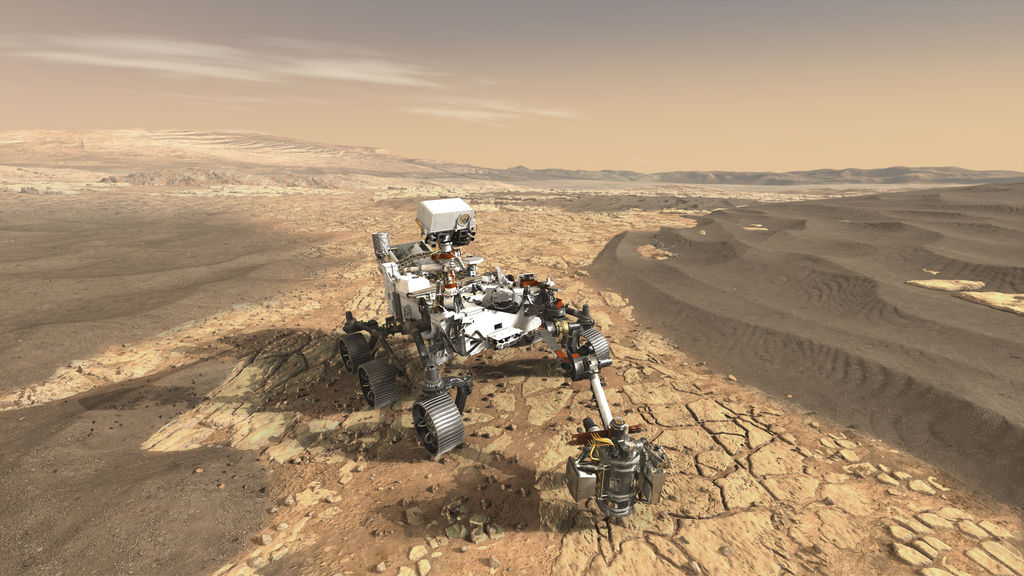
NASA’s Mars Perseverance rover on the surface of the Red Planet
-By Yagnamurthi Pooja
Despite being an awful year 2020 does pave a path for remarkable head starts that bought revolutionary changes. yeah!! You guessed it already!! Perseverance rover has launched on July 30, 2020, at 4:50 a.m.PDT(7:50 a.m. EDT) and it is making its way towards Mars successfully.
Perseverance is launched on Atlas V-541 rocket from complex 41 at cape Canaveral Air Force Station in Florida.
In this article, we are going to run you through the highlights of Mission Mars 2020. So, keep scrolling to know everything about the new rover
A Quick Guide
| Mission Name: Mars 2020 Rover Name: Perseverance Key objectives: 1. look for ancient life 2.Collect samples of rocks and soil 3.Demonstarte technology for future robotic and human exploration. Launch date: July 30, 2020 Landing date: Feb 18, 2021 Landing site: Jezero Crater, Mars |
Timeline of the mission
- The mission launch is planned between July-August 2020 from cape Canaveral Air Force Station, Florida
- The launching is done on a ULA Atlas 541.
- The rover lands on Mars on Feb 18, 2021, at the river delta
- Sicking the traces of life and explore the site takes one Mars year which is equal to two earth years.
- The imaging, chemical composition analysis, and mineralogy will be provided by Supercam. Roger Wiens will be the principal investigator
- An X-ray calledPIXL(Planetary Instrument for X-ray Lithochemistry) is used to map the fine-scale elemental composition of Martian surface material. Abigail Allwood will be the principal investigator
- The very first UV Raman spectrometer called SHERLOC will fly to mars
And this will provide the complementary measurements, it has a high-resolution color camera and Luther beagle will be the principal investigator
- A special technology called MOXIE (mars oxygen In-situ resource utilization Experiment) demonstrates that it can provide the oxygen from Martian atmospheric carbon dioxide. Michael Hecht will be the principal investigator. For complete details on this, visit: https://mars.nasa.gov/mars2020/spacecraft/instruments/moxie/
- A set of sensors called Mars Environmental Dynamics Analyser(MEDA) will provide the temperature, wind speed and direction, pressure, relative humidity, and dust size and shape. Jose Rodriguez-Manfredi will be the principal investigator. For complete details on this, visit: https://mars.nasa.gov/mars2020/spacecraft/instruments/meda/
- A specific Rader imager called RIMFAX ( Radar Imager for Mars’ Subsurface Experiment) is used to get the centimeter-scale resolution of the geological structure of the subsurface. Svein-Erik Hamran will be the principal investigator. For complete details on this, visit: https://mars.nasa.gov/mars2020/spacecraft/instruments/rimfax/
Current status of perseverance Rover
- Currently, the Perseverance rover is on its way to discover the traces of life and ready to explore the site, A ingenuity helicopter is also sent along with the rover.
- The rover will be landing on Feb 18, 2021
- By Feb 18, 2021 perseverance should cover 292.5 million miles and mars will be 130 million miles away from the earth and at this point, A transmission will take place to reach the spacecraft.
- This transmission takes around 11.5 min
The technology used in perseverance
The baseline of perseverance is adopted from the curiosity, in detail the baseline power system is called MMRTG(Multi-Mission Radioisotope Thermoelectric Generator) and the US Department of Energy provides it
Main hardware and dimensions of perseverance rover
Perseverance has 7 types of instruments in order to explore new technology and science on mars.it has a high-end camera system with panoramic and stereoscopic imaging capacity. The instrument will also help with the mineralogy of the martian surface and the principal investigator is James bell.
It has a cruise stage, the descent stage, and an aeroshell/heat shield which is inspired by the curiosity rover.
The perseverance is 10 feet long,9 feet widthwise, and 7 feet tall and it weighs around 2,260 pounds.
What makes the perseverance rover different from the curiosity rover?
The Perseverance rover is 278 pounds heavier than curiosity. The combination of the larger instrument suite, new sampling, caching system, and wheels are the reason behind the extra pounds.
Though the feature of the two rovers may seem the same their mission is different.
While Curiosity is identifying and exploring the environment and trying to find answers about the ancient microbes on the other hand perseverance is studying and tracing the ancient life by preparing the geological samples and trying to bring them back to the earth.
Source: Everyday astronaut you tube channel
Challenges faced by perseverance rover
The mission of the rover is all together challenging in the first place as the main goal is not just landing on the red planet it also has to work on scientific goals like tracing the ancient microbial life and analyzing the planets geology and climate and collecting the rocks and sediment samples for a future return to earth.
“Building this incredibly sophisticated rover has been the hardest thing I’ve ever been a part of as an engineer,” said Ray Baker, the mission’s flight system manager at NASA’s Jet Propulsion Laboratory in Southern California.
References
https://mars.nasa.gov/mars2020/
https://www.nasa.gov/feature/jpl/7-things-to-know-about-the-mars-2020-perseverance-rover-mission
















One Response